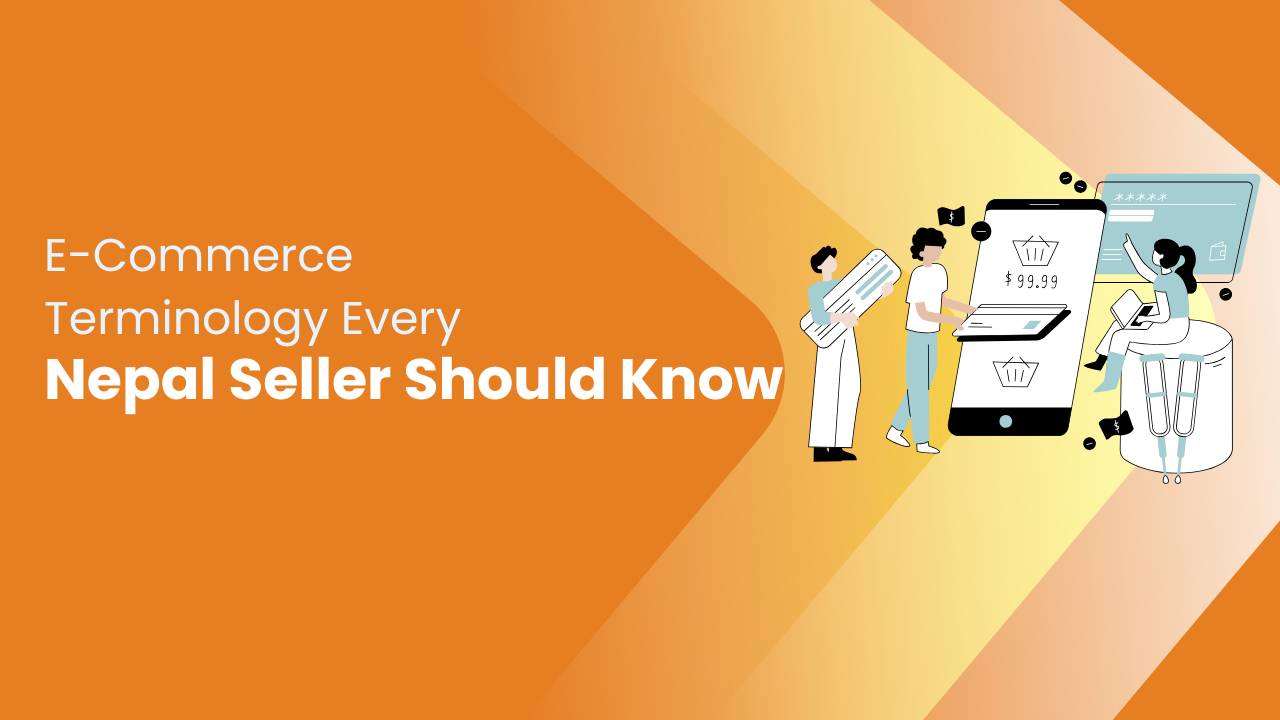Share this Article
Introduction and the Rise of E-Commerce in Nepal
The Meaning of E-Commerce in the Modern Nepali Context
E-commerce, short for electronic commerce, refers to the buying and selling of goods and services over the internet. While the term itself is widely used across the globe, its significance in Nepal has grown remarkably in recent years. With increasing internet penetration, the availability of smartphones, and the expansion of digital payment gateways, e-commerce has transformed from a futuristic concept to a daily reality in Nepali society. From small businesses to large-scale retailers, every seller now has the opportunity to reach a nationwide, and sometimes even international, audience through online platforms. For Nepali sellers, however, understanding e-commerce is not just about listing products online; it is also about knowing the language, concepts, and practices that govern this fast-growing industry.
The Changing Consumer Behavior in Nepal
In the past, Nepali consumers were more inclined toward physical marketplaces like Ason in Kathmandu or local haat bazaars in rural towns. Bargaining face-to-face and examining products physically were integral parts of shopping. However, the arrival of online marketplaces such as Daraz, SastoDeal, and other homegrown platforms has redefined shopping habits. Consumers today are looking for convenience, variety, and quick delivery. Young urban buyers, especially, prefer browsing products on apps and social media before making purchasing decisions. This cultural shift has created immense opportunities for sellers who are willing to embrace digital platforms. But in order to thrive, sellers must grasp the terminology that defines this space. Terms such as “conversion rate,” “logistics,” “payment gateway,” and “SEO” may seem foreign at first, yet they form the foundation of successful online selling.
Why Learning E-Commerce Terminology is Crucial for Nepali Sellers
In the competitive digital market, knowledge is power. A seller who does not understand basic e-commerce concepts can easily fall behind. For instance, if you are unaware of what “cart abandonment” means, you may not recognize why customers leave your site without completing a purchase. If you do not understand “digital marketing funnels,” you may struggle to design campaigns that convert viewers into buyers. Moreover, as Nepali sellers increasingly collaborate with international suppliers and service providers, familiarity with global e-commerce terms ensures smoother communication and professional credibility. Learning the right terminology helps sellers adapt quickly, adopt new strategies, and compete on equal footing with both local and global players.
The Expansion of Digital Infrastructure in Nepal
The rise of e-commerce in Nepal has been supported by gradual but important improvements in digital infrastructure. Internet service providers have expanded coverage even in semi-urban areas, while 4G networks have enabled smoother browsing experiences. Mobile wallets like eSewa, Khalti, and IME Pay have reduced the dependency on cash transactions, which were once seen as a barrier to online business. Logistics and courier companies, too, have evolved to serve the growing demand for doorstep delivery. All of these changes indicate that e-commerce is no longer an optional extra; it is becoming the backbone of retail in Nepal. As such, sellers need to keep up with industry trends, policies, and the terminology that governs their growth.
The Aim of This Article
This article is designed as a comprehensive guide for Nepali sellers to understand the most important e-commerce terminology. It is not merely a dictionary of terms but an exploration of how each concept applies to the Nepali business environment. By reading through each section, sellers will gain both the definitions and the practical insights required to implement them in their own business strategies. Each part will break down the terms in detail, explaining their relevance to Nepal’s unique market. Ultimately, by the end of this article, sellers will not only be familiar with the words but also with the strategies that these terms represent.
Core Business and Marketplace Terminologies
Understanding the Marketplace Model in Nepal
When we talk about e-commerce, one of the first terms sellers must know is the “marketplace model.” A marketplace is an online platform where multiple sellers list their products, and customers can browse, compare, and purchase from various vendors in one place. In Nepal, platforms like Daraz, SastoDeal, and OkDam follow this model. Instead of creating their own website and struggling to attract traffic, many Nepali sellers choose to start by listing their goods on these established marketplaces. The terminology associated with marketplaces—such as “seller dashboard,” “commission rate,” and “fulfillment center”—becomes essential knowledge for participating effectively.
Seller Dashboard
The “seller dashboard” is the control panel that every vendor receives after registering with an e-commerce platform. This is where sellers can upload product details, adjust prices, monitor sales performance, and manage inventory. In the context of Nepal, Daraz provides a dedicated dashboard that allows sellers to track orders and customer feedback. For new Nepali entrepreneurs, learning how to use the seller dashboard is similar to learning how to set up a shop window in a traditional bazaar—it is where your store comes alive.
SKU (Stock Keeping Unit)
A Stock Keeping Unit, often abbreviated as SKU, is a unique identifier assigned to each product in your inventory. For example, if you are selling shoes, each size and color variation should have its own SKU. In Nepal, where sellers often operate with limited stock and high demand, SKUs help prevent confusion and stockouts. Without SKUs, you may struggle to differentiate between similar products, leading to delivery mistakes and dissatisfied customers. Understanding SKUs also helps sellers integrate their inventory with logistics companies, ensuring smooth tracking and timely deliveries.
Commission Rate
Every marketplace charges sellers a fee for using their platform, commonly referred to as the “commission rate.” This is usually a percentage of each sale. For instance, Daraz Nepal charges different commission rates depending on the product category—electronics may have one rate, while fashion items may have another. For Nepali sellers, it is important to calculate profit margins after considering commission fees. Without this understanding, sellers may price their products too low and risk losing money, or too high and lose customers.
Fulfillment Center
A “fulfillment center” is a warehouse operated by the marketplace where sellers can store their products. The marketplace then handles packaging, shipping, and delivery. In Nepal, fulfillment centers are still developing, but Daraz has begun to offer such services in Kathmandu. Sellers who use fulfillment centers can benefit from faster deliveries and reduced operational hassle. However, they must understand terms like “storage fee,” “pick-and-pack fee,” and “last-mile delivery” to calculate costs effectively.
Inventory Management
Inventory management refers to the process of tracking and controlling stock levels. In e-commerce, this is done digitally, often through integration with the seller dashboard or third-party software. For Nepali sellers, inventory management is particularly crucial because supply chains can be disrupted by road conditions, strikes (bandh), or seasonal festivals like Dashain and Tihar, which see sudden spikes in demand. Mismanagement of inventory can lead to overselling or stockouts, both of which damage customer trust.
Product Listing
The term “product listing” refers to the way a seller presents their product online. A listing includes the product title, description, images, price, and other details. Strong listings attract customers, while poor listings reduce visibility and trust. For Nepali sellers, investing time in creating high-quality photos and writing detailed descriptions can significantly increase sales. For example, a product listed simply as “Women’s Dress” may get lost among hundreds of results, but a title like “Women’s Cotton Kurti – Handmade in Nepal, Available in Multiple Sizes” is more likely to stand out.
Customer Reviews and Ratings
In e-commerce, customer trust is built largely through reviews and ratings. These are the comments and star ratings left by buyers after receiving their orders. For Nepali sellers, positive reviews are especially valuable because many consumers are still skeptical about online shopping. A string of good reviews can reassure hesitant buyers and increase sales. On the other hand, negative reviews, if ignored, can damage a seller’s reputation. Learning how to respond professionally to criticism and improve service based on feedback is part of mastering the marketplace environment.
Buy Box
The “buy box” is the section of a product page where customers can click “Add to Cart” or “Buy Now.” On major marketplaces, multiple sellers may offer the same product, but only one seller gets featured in the buy box. Winning the buy box depends on factors like competitive pricing, fast delivery, and positive customer feedback. In Nepal, where competition on price is fierce, sellers must balance affordability with profitability to secure this position.
Cross-Border E-Commerce
Cross-border e-commerce refers to the selling and buying of goods across national boundaries. While Nepal’s cross-border e-commerce is still developing, sellers are increasingly exploring opportunities to export Nepali handicrafts, pashmina, tea, and handmade jewelry to international buyers through platforms like Etsy or Amazon. Terms such as “customs clearance,” “export documentation,” and “international shipping” become critical for sellers aiming to expand beyond the domestic market.
Digital Marketing and Customer Engagement Terminologies
The Role of Digital Marketing in E-Commerce
In today’s competitive online market, simply listing products on a marketplace or website is not enough. Sellers must actively reach out to potential customers through digital marketing. Digital marketing encompasses all efforts to promote products or services using online channels such as social media, search engines, email, and mobile apps. For Nepali sellers, this is especially important as consumer awareness and options continue to grow. Terms like SEO, PPC, conversion rate, and retargeting are no longer optional—they are integral to driving sales.
Search Engine Optimization (SEO)
SEO, or Search Engine Optimization, is the practice of improving your website or product listing so that it appears higher in search results. In Nepal, many online buyers use Google or marketplace search functions to find products. By using keywords relevant to Nepali consumers, writing clear product descriptions, and optimizing images, sellers can increase visibility. For example, including “handmade Dhaka topi Nepal” in your title and description ensures that buyers searching for traditional Nepali hats are more likely to find your product. SEO also extends to local searches, helping sellers appear in queries like “buy pashmina in Kathmandu.”
Pay-Per-Click (PPC) Advertising
PPC is a form of online advertising where sellers pay a fee each time their ad is clicked. Platforms such as Google Ads or social media sites like Facebook and Instagram allow Nepali sellers to target specific audiences based on location, interests, or shopping behavior. Understanding PPC terminology, such as “click-through rate (CTR)” and “cost-per-click (CPC),” helps sellers measure campaign effectiveness and adjust strategies to maximize return on investment.
Conversion Rate
Conversion rate refers to the percentage of visitors who complete a desired action, such as making a purchase or signing up for a newsletter. For example, if 100 people visit your online store and 5 make a purchase, your conversion rate is 5%. Nepali sellers need to track this metric closely because it reflects the effectiveness of their marketing efforts, product presentation, and website usability. Low conversion rates may indicate problems with pricing, product appeal, or checkout experience, all of which require corrective action.
Retargeting
Retargeting is a marketing strategy that targets users who have previously visited a website or interacted with an online store but did not complete a purchase. Through retargeting ads on social media or Google Display Network, sellers remind potential customers of products they showed interest in. For Nepali e-commerce, retargeting can be particularly effective during festivals like Dashain or Tihar, when buyers frequently browse products before committing to a purchase.
Customer Relationship Management (CRM)
CRM refers to the strategies and software used to manage interactions with customers. Effective CRM helps Nepali sellers track purchase history, respond to inquiries, and maintain long-term customer loyalty. Terms like “lead management,” “customer segmentation,” and “personalized email campaigns” are associated with CRM. A strong CRM strategy ensures that sellers can convert one-time buyers into repeat customers, which is essential for sustaining growth in Nepal’s e-commerce market.
Email Marketing
Email marketing involves sending targeted messages to a list of subscribers to promote products, announce sales, or provide updates. While Nepali sellers may initially find it challenging due to limited digital literacy among some consumers, email marketing can be highly effective for urban audiences. Terms such as “open rate,” “bounce rate,” and “unsubscribe rate” are key metrics that indicate the success of an email campaign. By analyzing these metrics, sellers can refine their communication to better resonate with potential buyers.
Social Media Marketing (SMM)
Social media platforms like Facebook, Instagram, TikTok, and YouTube play a crucial role in shaping consumer behavior in Nepal. Social Media Marketing involves creating engaging content, running paid advertisements, and interacting with followers to drive sales. Terms like “engagement rate,” “organic reach,” and “influencer marketing” are central to understanding how to effectively promote products online. Nepali sellers increasingly collaborate with local influencers to showcase handmade products, clothing, and traditional crafts, bridging the gap between online visibility and consumer trust.
Affiliate Marketing
Affiliate marketing is a performance-based strategy where sellers pay a commission to partners (affiliates) who promote their products. Affiliates earn money for each sale generated through their referral links. For Nepali sellers, affiliate marketing is still emerging, but it can be a cost-effective way to expand reach without significant upfront advertising expenses. Key terms include “affiliate link,” “commission structure,” and “referral tracking,” all of which must be understood to implement an effective affiliate program.
Customer Engagement Metrics
Engaging customers is not just about selling products—it is about creating an experience that encourages loyalty. Key metrics for measuring engagement include average session duration, page views per visit, and returning visitor rate. In Nepal, where brand loyalty is growing but trust in online platforms is still developing, monitoring these metrics helps sellers identify areas where the shopping experience can be improved. High engagement often translates into higher conversion rates and long-term success.
Payment, Shipping, and Logistics Terminologies
The Importance of Efficient Payment Systems
In e-commerce, a smooth and secure payment system is critical. In Nepal, digital payments have become increasingly popular through platforms like eSewa, Khalti, IME Pay, and direct bank transfers. Understanding payment-related terminology allows sellers to provide multiple options for customers, improving trust and conversion rates. For example, a customer may abandon a purchase if the only available payment method is cash on delivery, especially in urban areas where digital wallets are preferred.
Payment Gateway
A payment gateway is a technology that allows online transactions between the buyer, the seller, and the bank. It ensures secure processing of payments, protecting sensitive information like credit card numbers. Popular gateways in Nepal include eSewa Checkout and Khalti Payment Gateway. Sellers must understand terms like transaction fee, settlement period, and chargeback to manage costs and cash flow effectively.
Cash on Delivery (COD)
COD remains a widely used payment method in Nepal due to lingering distrust of online payments. It allows customers to pay only when they receive the product. While convenient for buyers, COD poses challenges for sellers, such as higher return rates and delayed cash flow. Understanding terms like failed COD attempts and return logistics is important for managing expectations and minimizing losses.
Digital Wallets
Digital wallets, such as eSewa and Khalti, store money electronically and allow for quick payments. They are increasingly popular in urban Nepal due to their convenience and integration with e-commerce platforms. Sellers should be familiar with terms like wallet balance, instant settlement, and refund processing to provide seamless transactions for customers.
Shipping and Delivery Terminology
Shipping is one of the most critical aspects of e-commerce. Nepali sellers must navigate terms like last-mile delivery, tracking number, delivery lead time, and logistics partner. Reliable delivery ensures customer satisfaction and repeat business. Many sellers collaborate with local couriers such as Nepal Post, Pathao, and private delivery companies. Understanding these logistics terms allows sellers to manage expectations, avoid delays, and handle disputes professionally.
Last-Mile Delivery
The term “last-mile delivery” refers to the final step of the shipping process, where a product reaches the customer’s doorstep. In Nepal, last-mile delivery can be challenging due to hilly terrain, remote villages, and traffic congestion in urban centers like Kathmandu and Pokhara. Efficient last-mile delivery ensures customer satisfaction and increases the likelihood of positive reviews.
Tracking Number
A tracking number is a unique code assigned to each shipment, allowing both sellers and customers to monitor the package’s journey. Sellers who provide real-time tracking updates gain customer trust and reduce inquiries about order status. Understanding terms like shipment status, in transit, and delivered is key for managing customer communication.
Delivery Lead Time
Delivery lead time is the period between order confirmation and final delivery. In Nepal, lead times vary depending on product location, warehouse availability, and courier reliability. Clear communication of expected delivery times can reduce customer frustration and improve retention. Terms like processing time and estimated delivery date help sellers provide accurate information.
Return and Refund Terminology
Returns and refunds are inevitable in e-commerce. Nepali sellers must understand terms such as return policy, RTO (Return to Origin), exchange, and partial refund. A clear and fair return policy builds customer confidence, while mishandling returns can harm the seller’s reputation. For example, timely processing of refunds through digital wallets or bank transfers is crucial for maintaining trust in Nepal’s competitive market.
Inventory and Shipping Integration
Integrating inventory with shipping systems helps streamline order fulfillment. Terms like automated shipping labels, warehouse sync, and stock alerts are common in e-commerce platforms. For Nepali sellers, integration reduces human errors, prevents stockouts, and ensures timely deliveries, which is especially important during peak festival seasons.
Logistics Partner
A logistics partner is a company responsible for transporting goods from the seller to the customer. In Nepal, sellers often work with multiple partners depending on location, product size, and urgency. Understanding terms such as courier charges, service-level agreement (SLA), and reverse logistics ensures smooth collaboration and better customer service.
Analytics, Performance, and Growth Terminologies
The Role of Analytics in E-Commerce
Analytics is the backbone of strategic decision-making in e-commerce. Nepali sellers, like their global counterparts, can use data to understand customer behavior, track performance, and identify growth opportunities. Without analytics, businesses rely on guesswork, which can lead to wasted resources and missed opportunities. Key terminology in this area helps sellers interpret data correctly and make informed decisions.
Traffic and Visitors
“Traffic” refers to the number of users visiting a website or online store. For marketplaces, it includes visits to product listings or storefronts. “Visitors” can be further classified as unique or returning. Nepali sellers must track traffic sources—whether organic, paid, or social—to understand which marketing strategies are effective. High traffic without conversions may indicate issues with product appeal or checkout processes, while low traffic signals the need for stronger promotion.
Bounce Rate
Bounce rate is the percentage of visitors who leave a website without taking any action, such as viewing multiple pages or making a purchase. For Nepali sellers, a high bounce rate may indicate slow website loading, unclear product information, or unappealing design. Reducing bounce rate involves optimizing website speed, providing detailed product descriptions, and creating engaging visuals.
Conversion Funnel
The conversion funnel is a model that illustrates the journey of a potential customer from awareness to purchase. It includes stages like awareness, consideration, decision, and purchase. Nepali sellers who understand the conversion funnel can design strategies to guide customers at each stage. For example, social media ads may create awareness, while email reminders can nudge users toward completing their purchase.
Average Order Value (AOV)
Average Order Value measures the average amount spent by a customer per transaction. Increasing AOV is a key growth strategy for sellers. In Nepal, sellers can boost AOV through upselling, cross-selling, or offering bundle deals. Understanding the concept helps sellers optimize pricing, promotions, and inventory management.
Customer Lifetime Value (CLV)
CLV represents the total revenue a business can expect from a single customer over the entire relationship. For Nepali e-commerce sellers, building customer loyalty through quality products, timely delivery, and excellent service increases CLV. Higher CLV allows sellers to invest more in marketing while maintaining profitability.
Return on Investment (ROI)
ROI measures the efficiency of an investment, such as an advertising campaign or promotional activity. In e-commerce, calculating ROI involves comparing the revenue generated against the cost of marketing, logistics, or product development. For Nepali sellers, tracking ROI ensures that resources are allocated effectively and campaigns deliver measurable value.
Cart Abandonment Rate
Cart abandonment occurs when a customer adds products to their cart but does not complete the purchase. In Nepal, common reasons include high shipping costs, lack of preferred payment options, or complicated checkout processes. Sellers can reduce abandonment rates by simplifying checkout, offering digital wallet payments, and sending follow-up reminders.
Key Performance Indicators (KPIs)
KPIs are measurable values used to assess business performance. Common e-commerce KPIs include sales revenue, conversion rate, traffic sources, AOV, and customer retention rate. Nepali sellers must select relevant KPIs and monitor them regularly to ensure growth. KPIs act as a roadmap, helping sellers identify strengths, weaknesses, and opportunities in their operations.
Customer Retention Rate
Customer retention rate measures the percentage of repeat buyers over a specific period. In Nepal, retaining customers is more cost-effective than acquiring new ones. Sellers can improve retention through loyalty programs, discounts for returning customers, and excellent post-purchase support. Understanding retention metrics helps sellers build sustainable long-term businesses.
Growth Metrics
Growth metrics go beyond immediate sales and track overall business expansion. Terms like market share, brand awareness, and repeat purchase rate indicate whether a business is scaling successfully. Nepali sellers who monitor these metrics can adjust strategies proactively, ensuring competitiveness in a rapidly evolving digital market.
Conclusion: Mastering E-Commerce for Nepali Sellers
E-commerce in Nepal is no longer a niche concept—it has become a vital part of the retail landscape. From bustling marketplaces in Kathmandu to rural villages increasingly connected by mobile internet, digital commerce offers unprecedented opportunities for Nepali sellers. However, thriving in this competitive space requires more than just listing products online. It demands a solid understanding of the terminology, concepts, and strategies that govern the industry.
Throughout this article, we explored the essential terms that every Nepali seller should know. From marketplace models, seller dashboards, SKUs, and fulfillment centers to payment gateways, cash-on-delivery options, shipping logistics, and last-mile delivery, the foundation of e-commerce is built on knowledge. Digital marketing concepts such as SEO, PPC, retargeting, CRM, and social media engagement are equally important, as they directly influence visibility, customer trust, and sales. Analytics and growth terminologies like conversion rate, AOV, CLV, ROI, and retention metrics provide insights that help sellers make informed decisions, optimize performance, and scale sustainably.
For Nepali sellers, understanding these terms is not merely academic—it has practical implications. Each concept represents a tool that can improve customer experience, streamline operations, and boost profitability. Whether you are a small-scale artisan selling handicrafts online or a growing business aiming to expand nationwide, mastering e-commerce terminology empowers you to communicate effectively with platforms, customers, and logistics partners. It also prepares you to adapt to global trends, experiment with innovative marketing strategies, and leverage technology to overcome local challenges such as delivery delays, payment hesitancy, or seasonal demand fluctuations.
In conclusion, knowledge is the most valuable asset for any Nepali seller venturing into e-commerce. By investing time in learning the language of online business, understanding key processes, and applying best practices, sellers can transform challenges into opportunities. The digital marketplace is dynamic and ever-evolving, but those who grasp the terminology and apply it strategically are well-positioned to succeed. E-commerce is not just about selling products online—it is about building relationships, creating trust, and delivering value. For Nepali sellers, mastering e-commerce terminology is the first step toward achieving long-term growth, sustainability, and a competitive edge in an increasingly digital Nepal.
Categories:
E-commerce Tips & Tutorials
Tags:
E-commerce
,
Seller







